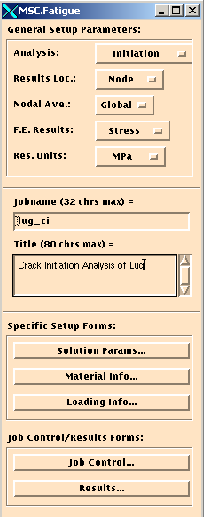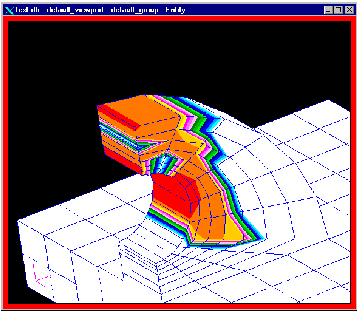XXXXXXXXXXXXXXXXXXXXXXXXXXXXXXXXXXXXXXXXXXXXXXXXXXXXXXXXXXXXXXXXXXXXXXXXXXXXXXXXXXXXXXXXXXXXXXXXXXXXXXXXXXXXXXXXXXXXXXXXXXXXXXXXXXXXXXXXXXXXXXXXXXXXXXXX''"> ε-N Analysis of Lug
Now set up a Crack Initiation analysis of the lug itself. We are not concerned about where this crack will initiate since we know this due to the nature of the simple loading, i.e., the high stress area. We wish to determine the life until a crack initiates in the hole. Set the General Setup Parameters as follows:
1. Analysis: Initiation
2. Results Loc.: Node
3. Nodal Ave.: Global
4. F.E. Results: Stress
5. Res. Units: MPa
6. Jobname: lug_ci
7. Title: Crack Initiation Analysis of Lug
Solution Parameters
Accept all the defaults on this form.
Material Information
The material used in this analysis is BS4360-50D. This material is already in the materials database. Assume there is a good machined finish with no surface treatment. Open the Material Info... form and fill out the spreadsheet as follows:
1. Material: BS4360-50D
2. Surface Finish: Good Machined
3. Surface Treatment: No Treatment
4. Region: default_group
5. This group contains the nodes for the entire model.
Loading Information
The load history is identical to that of the S-N analysis of the lug weld problem.
Job Control
Open the Job Control... form and set the Action to Full Analysis and click the Apply button to run the job. Monitor the job form time to time until it is complete.
Results
Open the Results... form from the main MSC Fatigue setup form and read the results in.
Do a contour plot of the log of the life (in Years) or list the results using PFPOST to identify the node with the shortest life. Note that the initiation life is approximately 3000 cycles at Node 7 or about 4 years assuming 2 lifts per day.
On the Results... form set the Action to Optimize, select Node 7 to run the design optimization mode of FEFAT. Set the design life to 100. After reanalyzing Node 7 and entering into the main menu, do a Sensitivity analysis on surface Finishes (all). Do not forget to press the Recalculate switch. Note that a polished surface only increases the life to less than 6 years. This is obviously not sufficiently long, even with a polished surface.
The Safe Life design philosophy would have us scrap this component after 4 to 6 years depending on surface finish/treatment we could apply or impose. This would be OK if the component were small and inexpensive and easy to replace such as automobile parts. However, this is not an option in the case, and the existence of a crack will not hinder the operation, nor is it a safety critical item. However, this calculation is only to crack initiation. There may still be many years of life left in this assembly depending on how fast this crack propagates.


